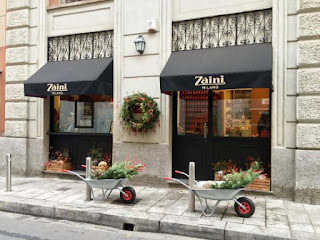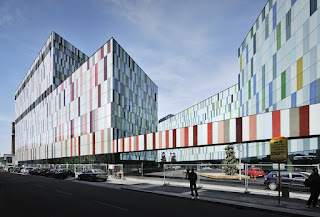NEW - Zàini - Milan chocolate manufacturer
First factory opened in Via Carlo de Cristoforis
The Milan chocolate producer Zàini was founded on this day in 1913 when the company’s first factory opened in the Porta Garibaldi district of the city. The plant, opened by Luigi Zàini, a young entrepreneur, in Via Carlo de Cristoforis, was advertised as a ‘Factory of Chocolate, Cocoa, Candies, Jams and Similar’. Zàini, who had experience in the confectionery business as an importer of biscuits, jams and other sweet products from northern Europe, had noted the rapidly growing popularity of chocolate and thought the time was right to move on from his role as middleman and become a producer in his own right. In Milan at the time there were around 15 chocolate factories, so competition was keen, but Luigi had a unique selling point in mind. His dream was to be able to satisfy any wish for something sweet, reportedly saying: “Everyone is different, so why aren’t we creating lots of different chocolates and sweets for each different person?”. Luigi flavoured his bars with rum, mandarin, vanilla and aniseed among other things and made them stand out by wrapping them in coverings inspired by the fashion for Stile Liberty design in architecture, furniture and decorative art. Read more…
_______________________________________
Licia Albanese – soprano
Butterfly had a long career
Operatic soprano Licia Albanese, whose portrayal of Verdi and Puccini heroines delighted audiences all over the world during the last century, was born on this day in 1909 in Bari in the region of Puglia. She made her operatic debut unexpectedly in 1934 at the Teatro Lirico in Milan during a performance of Giacomo Puccini's Madama Butterfly. Albanese was understudying the title role and when the soprano became ill during Act One, she was hustled on to the stage to take over in Act Two. She was a great success and during the next 40 years sang more than 300 performances in the role of Cio-Cio-San, the geisha who is better known as Madama Butterfly. Her connection with the opera began early when she was studying with the singer, Giuseppina Baldassare-Tedeschi, who was a contemporary of Puccini, and had been the greatest Butterfly of her day. Albanese went on to appear at La Scala, Covent Garden and many other European houses, also winning praise for her portrayals of Mimi, Violetta and Manon Lescaut. She was fortunate to have as tenor partners, singers of the calibre of Tito Schipa, Beniamino Gigli and Giacomo Lauri-Volpi. Read more…
____________________________________
Damiano Damiani – screenwriter and director
Filmmaker behind the hit Mafia drama series La piovra
Damiano Damiani, who directed the famous Italian television series La piovra, which was about the Mafia and its involvement in Italian politics, was born on this day in 1922 in Pasiano di Pordenone in Friuli. Damiani also made a number of Mafia-themed films and he was particularly acclaimed for his 1966 film, A Bullet for the General, starring Gian Maria Volontè, which came at the beginning of the golden age of Italian westerns. Damiani studied at the Accademia di Brera in Milan and made his debut in 1947 with the documentary, La banda d’affari. After working as a screenwriter, he directed his first feature film, Il rossetto, in 1960. His 1962 film, Arturo’s Island, won the Golden Shell at the San Sebastian International film festival. During the 1960s, Damiani was praised by the critics and his films were box office successes. A Bullet for the General is regarded as one of the first, and one of the most notable, political spaghetti westerns. Its theme was the radicalisation of bandits and other criminals into revolutionaries. Damiani’s 1968 film, Il giorno della civetta - The Day of the Owl - starring Claudia Cardinale, Franco Nero and Lee J Cobb, started a series of films that blended social criticism with spectacular plots. Read more…
______________________________________
Francesco Cilea – opera composer
Calabrian remembered for beautiful aria Lamento di Federico
Composer Francesco Cilea was born on this day in 1866 in Palmi near Reggio di Calabria. He is particularly admired for two of his operas, L’arlesiana and Adriana Lecouvreur. Cilea loved music from an early age. It is said that when he was just four years old he heard music from Vincenzo Bellini’s opera, Norma, and was moved by it. When he became old enough, he was sent to study music in Naples and at the end of his course of study there he submitted an opera he had written, Gina, as part of his final examination. When this was performed for the first time it attracted the attention of a music publisher who arranged for it to be performed again. Cilea was then commissioned to produce a three-act opera, meant to be along the lines of Pietro Mascagni's Cavalleria rusticana, by the same publisher. The resulting work, La Tilda, was performed in several Italian theatres, but the orchestral score has been lost, which has prevented it from enjoying a modern revival. In 1897, Cilea’s third opera, L’arlesiana was premiered at the Teatro Lirico in Milan. In the cast was the young Enrico Caruso, who performed, to great acclaim, the famous Lamento di Federico, often known by its opening line, È la solita storia del pastore. Read more…
_____________________________________
Sergio Mattarella – President of Italy
Anti-Mafia former Christian Democrat is Italy's 12th President
The first Sicilian to become President of Italy, Sergio Mattarella, was born on this day in 1941 in Palermo. Mattarella, who has occupied the office since 2015, went into politics after the assassination of his brother, Piersanti, by the Mafia in 1980. His brother had been killed while holding the position of President of the Regional Government of Sicily. Their father, Bernardo Mattarella, was an anti-Fascist, who with other prominent Catholic politicians helped found the Christian Democrat (Democrazia Cristiana) party. They dominated the Italian political scene for almost 50 years, with Bernardo serving as a minister several times. Piersanti Mattarella was also a Christian Democrat politician. Sergio Mattarella graduated in Law from the Sapienza University of Rome and a few years later started teaching parliamentary procedure at the University of Palermo. His parliamentary career began in 1983 when he was elected a member of the Chamber of Deputies in a left-leaning faction of the DC that had supported an agreement with the Italian Communist Party led by Enrico Berlinguer. The following year he was entrusted with cleansing the Sicilian faction of the party from Mafia control. Read more…
______________________________________
Book of the Day: Chocolate: An Italian Passion, by Roberta Deiana
The Italian passion for chocolate goes back more than 100 years. Chocolate: An Italian Passion is a fabulously illustrated and lighthearted romp through the history of this love affair: from society ladies’ cups of hot chocolate in the early part of the 20th century through the chocolate substitutes of Fascist era self-sufficiency; from the chocolate ‘rations’ handed out by friendly American soldiers in WW2 to the postwar boom years when what was once a rare and expensive treat at last became a regular indulgence available to everyone. Arranged chronologically, 30 recipes and accompanying stories go from the early 1900s to date - from chocolate ice cream in 1910 to a chocolate and chilli cheesecake in 2000.Roberta Deiana is a Milan-based cookery writer, food stylist, and blogger. This is her fourth food book.
.jpg)


.jpg)



.jpg)
.jpg)


.jpeg)

.jpg)


%20(2).jpg)

.jpg)
.jpg)

